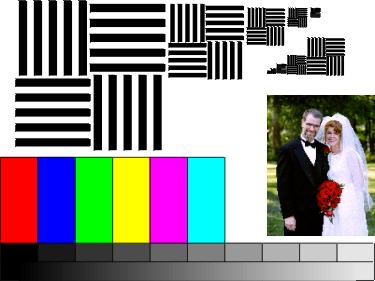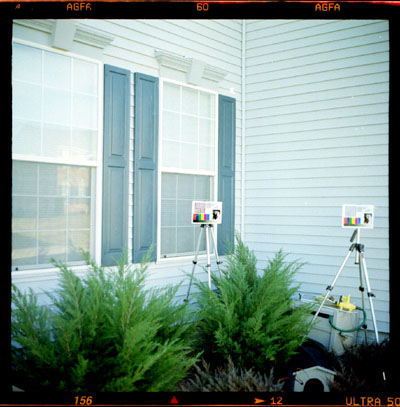Lens Testing, Round 1
Part 1. A Practical, but Not Rigorous Lens Test
The Zeiss Jena lenses that fit my Kiev 60 are supposed to be the best, and the 30, 80 and 120mm Arsenal lenses made in Kiev are supposed to be outstanding. The 45mm wide-angle lens is supposed to be a dog, and the teleconverter is supposed to be good.
But "supposed to be" and "really are" are two different things. Variability reigns supreme. First, there's little or no quality control at the factory, so one lens my be superior and the next lens unusable. And some of these are old, with who knows what abuse and results thereof.
My objective is not a detailed quantitative test, but a general idea of what I can expect in the field.
The results held a few surprises, but mostly reinforced what we already know.
The test comprised setting up two test targets in my front yard. The targets were created on the computer and printed at 8x10 on the Epson printer, and contain line-pair test targets ranging at 0.2, 0.1, 0.05, 0.025, and 0.0125" intervals. For the 0.2" interval, the bar was 0.1" wide, and the bars were separated by a 0.1" space. The bars and spaces were always the same width. The target also include a gray scale and color bars, and a photo from my wedding printed at about 3"x4".

For discussion, I have identified the groups of bars as Group 1, the biggest, Group 2, the second biggest, Group 3, which appears twice in the image, and Group 4, though only one lens even approached that value. I normalized all scans by setting the white point on the background of the center target and the black point on the tuxedo jacket in the inset photo. The image of the target presented above is a compressed bitmap, and the compression algorithm had a little trouble with those hard edges. The real targets were crisp and resolvable down to Group 6, where the white bar was 0.00313" wide, or either 4 or 5 pixels wide on the 1440 dpi printer. The lines in Group 7 were a bit uneven, being either 2 or 3 pixels wide, but were still resolvable.
The two targets were placed 6 feet apart, and I took two pictures with each lens. The camera was placed such that one target was in the center, and the other at the edge of the frame. I repositioned the camera for each lens to maintain the field of view. The subject distance ranged from about 75 feet for the 2x-converted Sonnar to about 3 feet for the fisheye, though I didn't measure it precisely. The tripod was a Bogen 3036/3047 combination (read: Big and heavy), and the camera a '94 Kiev 60. The background was my gray house, lit by shaded blue sky. The camera was always in the shade of the house except with the Sonnar, when I used the factory shade.

The two shots were made at apertures f/2.8, 3.5, or 4 (wide open) and at f/8. I made no attempt to find the optimal aperture. If f/8 is far enough from optimal to matter, then I don't care and don't want the lens. The film was Agfa Ultra 50, and the shutter speeds were 60 or 125 for the wide aperture and 8 or 15 for f/8, generally speaking (variations caused by teleconverter use or different lens speeds). Metering was done in the camera.
I scanned the films in the Acer 1240, and then cut the 120 film into 35mm strips. I then looked at them under a 30x microscope to determine which groups of line pairs could be resolved in the negative. The scans shown herein were made on a 2700 dpi film scanner. When displayed on a screens with typical 80-100-pixels/inch resolution, that approximates the view in my microscope. The difference is that the microscope lens is sharp and analog, and does not introduce the aliasing evident in the scans. I also view the negatives to confirm my findings with a 100x microscope.
(Note to earlier readers: I upgraded these scans on 3/19/01, based on the discovery that my scanner was not operating at full resolution before. The scanner operation is still erratic and unpredictable, and I am considering an alternative approach to presenting these images. Watch this space.)
Realize that I'm testing the entire chain of equipment: Camera, tripod, lens, film, and magnification device. Any flaw anywhere will affect the result. But that's in line with my objectives: I want to know what I can expect from my lenses and techniques, not what my lenses will do on an optical bench.
I didn't include fine enough gradations in my test target, so the best I can do is report ranges. If the resolution target was just barely resolved, then I reported the value for that target (e.g. 22 or 44). It if clearly resolved one target but clearly not the next one, then I report a range that is half of the range between those two targets and centered between them (e.g. 27-38). If it showed an obvious tendency towards one target or the other, then I report half the range from the tended-to target to the middle of the range. (e.g. 22-33 or 33-44). I determined these values by counting the number of pixels from one line to the next on the 2700 pixel/inch scans. For example, if the lines are 9.5 pixels apart (counting four lines and averaging), then the resolution represented by those pairs is (2700 pixels/inch) / [(9.5 pixels/line) * (25.4 mm/inch)] = 11 lines/mm. This was the resolution of Group 2 for all lenses except the fisheye, meaning that Group 3 represents 22 lines/mm, Group 4 represented 44 lines/mm, and Group 5 represents 88 lines/mm. The Arsat fisheye, because of fisheye distortion, yielded a larger image of the targets than the rectilinear lenses. Therefore, the values for that lens are 10% less.
The Tests
The lenses under test are as follows:
| Lens | Age | Coatings | Condition as Bought | Source |
| 30mm f/3.5 Arsat | '97 | Multicoated | New. I removed the front element to remove dust. | Genna Kaplan Russian Plaza |
| 45mm f/3.5 Harblei PCS (shift-only) | 2000 | Multicoated | New | Mike Fourman KievCamera |
| 45mm f/3.5 Mir 26b | '83 | Coated (Barely) | Used, like new | Genna Kaplan |
| 50mm f/4 Carl Zeiss Jena Flektogon | Late-model black body | Multicoated (but not marked MC) | Used, excellent | Mikhail Fourman KievCamera |
| 80mm f/2.8 Arsat | '96 | Multicoated | New | Mikhail Fourman |
| 80mm f/2.8 Volna | '87 | Multicoated | New old stock | Yury Korchinsky "Lemiu" |
| 120mm f/2.8 Vega | '93 | Multicoated | Used, excellent, except for a sticky aperture which I adjusted. | Michel Dumas |
| 180mm f/2.8 Carl Zeiss Jena Sonnar | Older "Zebra" version | Coated | Used in average condition. I disassembled lens to clean and lubricate, but did not disassemble optics. | Yury Korchinsky |
| 240mm | Vega with Arsenal 2X converter | Converter Multicoated | Converter as new old stock | Converter: Pavel Gubanov |
| 360mm | Sonnar with 2X converter | Converter Multicoated | as above | as above |
Here are the results:
Wide Open Resolution
Resolution is measured in lines/mm, and provided in a range of values, unless it was clear that the target was right at the border of resolving power.
| Lens | Center Resolution | Edge Resolution | Comments |
| 30mm Arsat | 40-60 | 20-30 | moderate edge color (chromatic aberration) |
| 45mm Hartblei | 27-38 | 22 | better than the identical-but-poorly coated Mir |
| 45mm Hartblei, shifted 12mm | 11-22 | 22-33 | but not as good shifted |
| 45mm Mir26 | 22-33 | 16-22 | slight color on edge |
| 50mm Flektogon | 27-38 | 13-18 | moderate coma (vertical better than horizontal) |
| 80mm Volna | 33-44 | 22-33 | low contrast at edge, slight coma |
| 80mm Arsat | 33-44 | 22-33 | low contrast at edge |
| 120mm Vega | 27-38 | 27-38 | low contrast at edge |
| 240 2X Vega | 22-33 | 22 | lower contrast than f/8, slight coma |
| 180 Sonnar | 27-38 | 44 | crisp--no color or coma |
| 360 2X Sonnar | 22 | 22 | low contrast, with slight edge color |
These values are higher than were earlier reported on these pages, as a result of using a 30x microscope instead of a 15x loupe. This new equipment led me to reevaluate the pixel counting I did to determine line spacing.
"Optimal Aperture" Resolution at f/8
Resolution is measured in lines/mm, and provided in a range of values, unless it was clear that the target was right at the border of resolving power.
| Lens | Center Resolution | Edge Resolution | Comments |
| 30mm Arsat | 50-70 | 30-40 | moderate edge color (chromatic aberration) |
| 45mm Hartblei | 22-33 | 22-33 | |
| 45mm Hartblei, shifted 12 mm |
22-33 | 27-38 | considering the shift, edge performance is outstanding |
| 45mm Mir26 | 44 | 22 | no color |
| 50mm Flektogon | 44-66 | 22 | still some coma, but better |
| 80mm Volna | 33-44 | 27-38 | slight coma and color at edge |
| 80mm Arsat | 44 | 33-44 | slight color at edge |
| 120mm Vega | 44 | 33-44 | |
| 240 2X Vega | 22-33 | 22 | as above. |
| 180 Sonnar | 44 | 27-38 | worse than wide open at the edges, showing color |
| 360 2X Sonnar | 22-33 | 22 | low contrast with slight edge coma |
Some surprises here. The Sonnar raises some points. Why is edge performance worse stopped down? We will explore this mystery later on.
In the next four pages, we will look at the high resolution images of the test targets. In the last two pages, we will look into the Sonnar issue and also look at vignetting. Be patient--the files are large and take a while to download if you have a slow connection, but I've spread it out across a number of pages to keep it from being totally unreasonable.